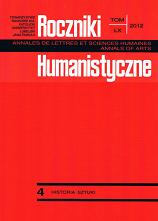Vasari, Bellori, Lanzi - trzy filary włoskiej historiografii artystycznej
Vasari, Bellori, Lanzi - three pillars of Italian artistic historiography
Author(s): Magdalena MichałowiczSubject(s): Cultural history
Published by: Towarzystwo Naukowe KUL & Katolicki Uniwersytet Lubelski Jana Pawła II
Keywords: historiography; Italian art; history of history of art; writing on art; lives; the cyclical model of art development; historiografia; sztuka włoska; historia historii sztuki; piśmiennictwo o sztuce; żywoty; cykliczny model rozwoju sztuki
Summary/Abstract: From the middle of the 16th century, when the first edition of Giorgio Vasari’s Lives of the Most Eminent Painters, Sculptors, and Architects appeared, until the threshold of modernity, the unusually influential conceptions concerning the development of art contained in the book, albeit criticized from various angles, were not in fact undermined as far as their foundations are concerned. Nevertheless, the 17th and 18th century Italian artistic historiography, as one that was formed in a different context and tried to describe and indicate the origin of art. created by artists who started setting different goals, differed from the 16th century art in many details. They are shown in the article by confronting Vasari's ideas with the visions of art. presented by his great successors: Gian Pietro Bellori in his Lives of the Artists (1672) and Luigi Lanzi's History of Painting in Italy; From the Period of the Revival of the Fine Arts to the End of the Eighteenth Century (1796). Special attention is paid to the changing conception of art, the changing artistic ideas and the historical awareness that was being born, leaning towards reformulating the time-honored vision of history.
Journal: Roczniki Humanistyczne
- Issue Year: 60/2012
- Issue No: 04
- Page Range: 177-204
- Page Count: 28
- Language: Polish

